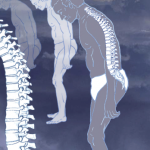Although imaging often dominates the discussion of axSpA, physical findings are nevertheless important for assessing diagnosis, outcomes and treatment effects. Bento da Silva and colleagues, therefore, assessed measures of spine and hip mobility in patients with axSpA and non-axSpA chronic back pain with two or fewer years of symptoms. The measures assessed included such classics as occiput-to-wall (OWD), chest expansion and the modified Schober (mShober) tests. Data were available both at baseline and after two years.
For both groups, about 50% of patients had one or more measure of impaired spinal mobility, with overall poorer mobility in the non-axSpA patients except for OWD. After two years, mobility remained largely unchanged in both groups although axSpA was associated with larger improvements in mSchober but higher odds of OWD impairment.
These are very interesting findings and raise the question of the origin of mobility impairment in both populations. A comparison with radiographs would be important especially among the patients with non-axSpA. As someone who has often used mobility measures to screen for axSpA, I will be mindful in the future of the limitation of the physical findings in clinical assessments.
AMH Titers in Women with axSpA
Abstract 0577: Franc et al.9
Perhaps the largest genetically determined factor in inflammatory disease relates to male-female differences, which can impact clinical manifestations, disease outcomes and treatment responses. Further, with women, inflammatory disease can influence fertility and pregnancy outcomes, issues for which new data are urgently needed as the treatment armamentarium changes. Franc et al. studied the expression of anti-Mullerian hormone (AMH), an indicator of ovarian reserve, in 381 women in the DESIR cohort over 10 years. Overall, AMH levels in the cohort were significantly lower than those of the controls for all age groups. Further, the study showed two trajectories of AMH decrease: a lower AMH level at age 18 with a slow decline to age 45 and a higher AMH level at age 18 followed by a steeper decline.
Although many factors could influence these trajectories (e.g., inflammation, treatment), the study highlights the need to understand better the interplay of disease and fertility; it also suggests the value in clinical studies as well as routine care to assess markers such as AMH.
NSAIDs & Incident Hypertension
Abstract 0540: Meade Aguilar et al.10
Non-steroidal anti-inflammatory drugs (NSAIDs) are effective agents for the treatment of axSpA, with a response to NSAIDs one of the indicators for the presence of inflammatory back disease. The toxicity of these agents (e.g., gastrointestinal, cardiovascular) has always been a concern and has constrained chronic usage. Meade Aquilar and colleagues revisited this issue by assessing hypertension in a longitudinal cohort (DESIR) of patients with early axSpA, determining hypertension by patient self-report, medication usage or blood pressure measurements at two visits. Of the patients, two-thirds were on NSAIDs at the time of baseline, and incident hypertension occurred in 11%. Nevertheless, the analysis failed to find a relationship between high-dose NSAID use and incident hypertension after adjustment for confounders.


